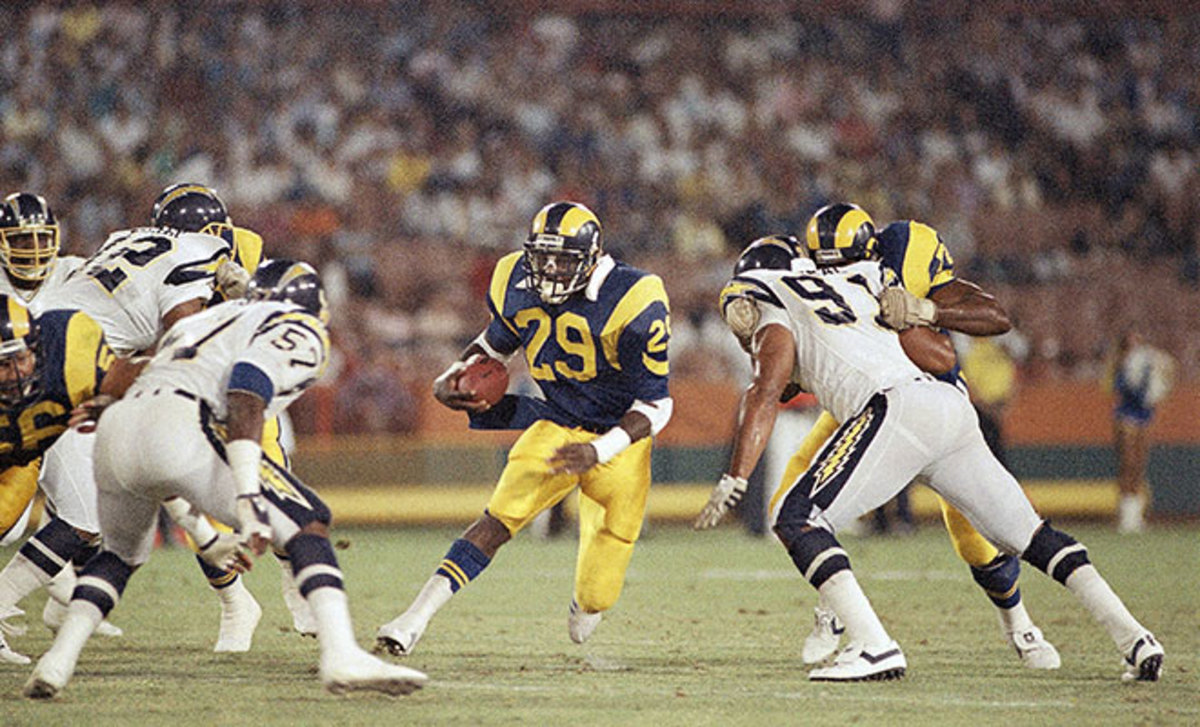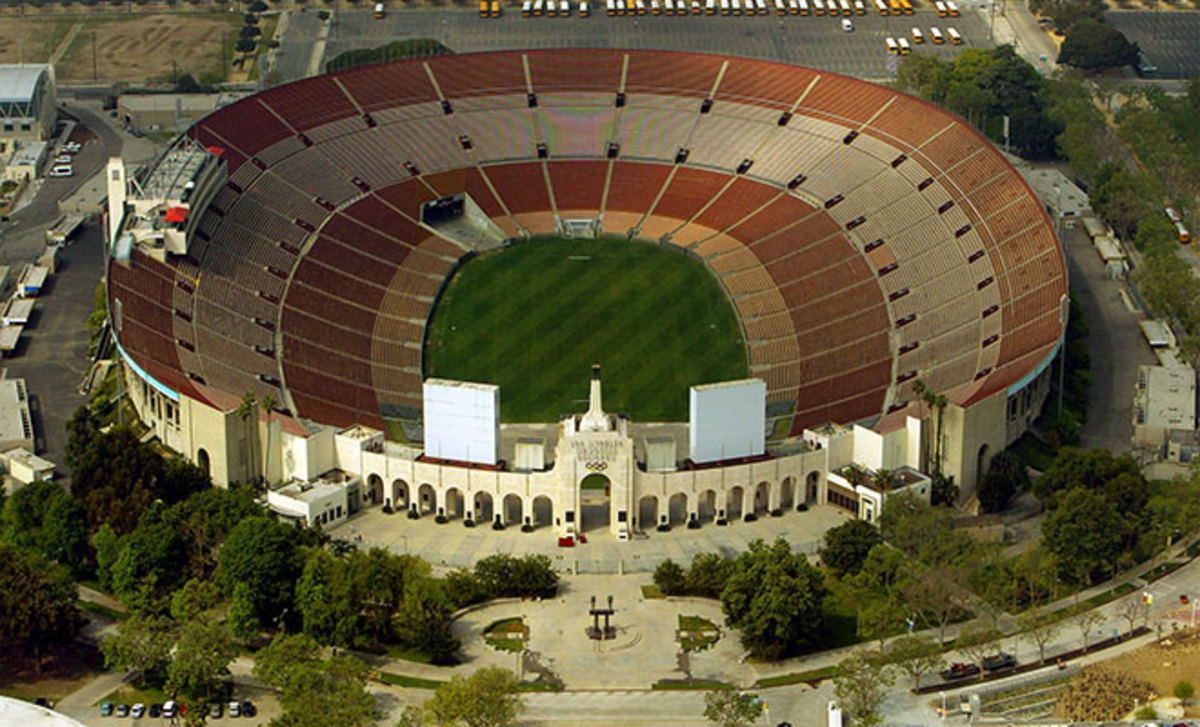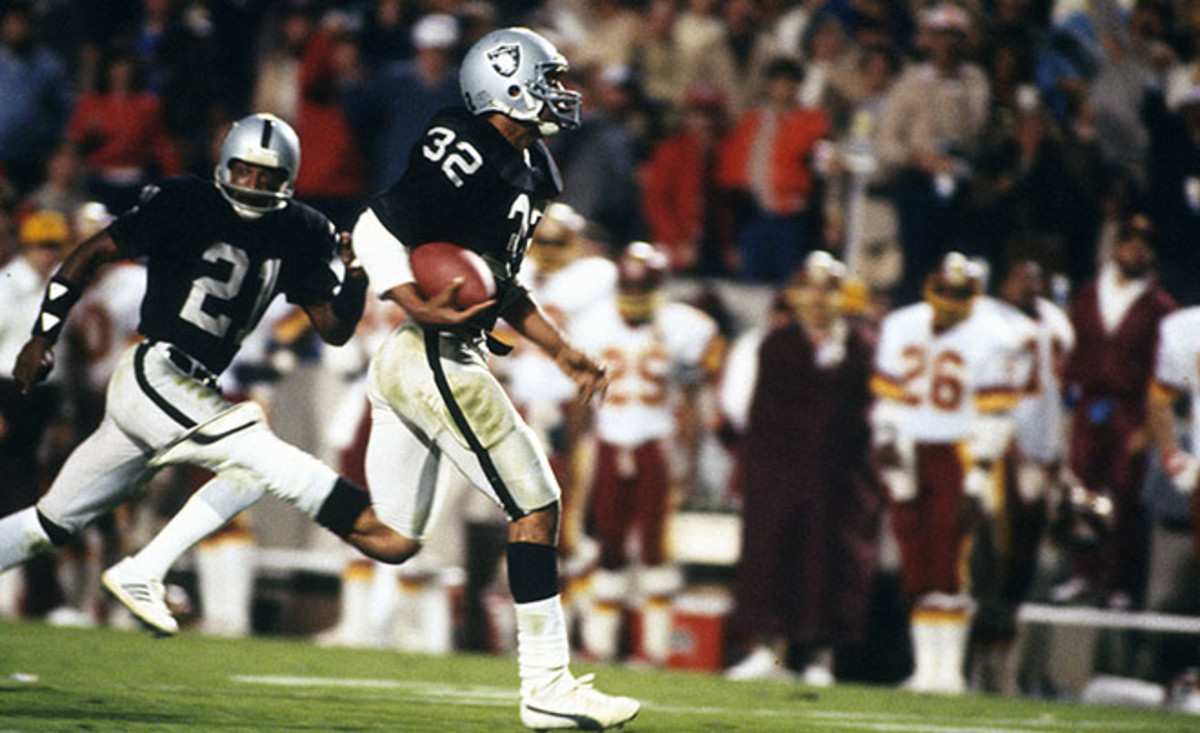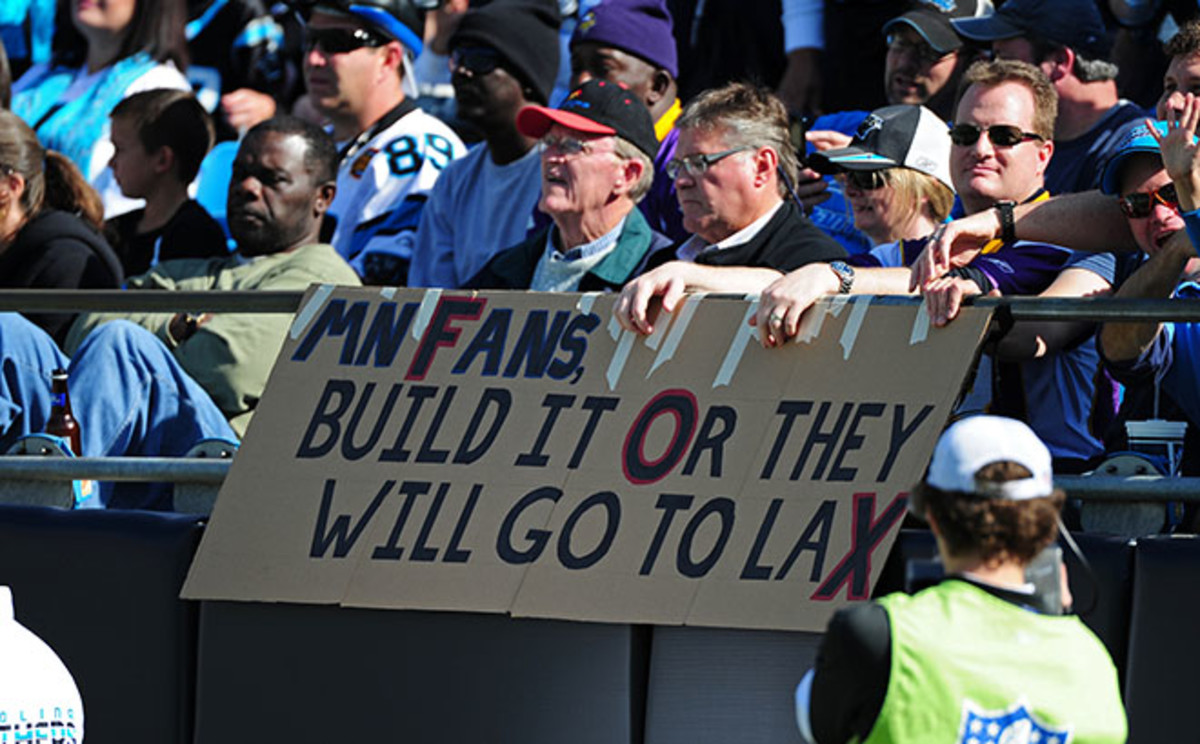The rise, fall and return of the NFL in Los Angeles

It has been more than 20 years since an NFL game was played in Los Angeles, but the league appears to be on the verge of returning.
The NFL announced on Jan. 4 that the Oakland Raiders, San Diego Chargers and St. Louis Rams have all applied to relocate to Los Angeles, bringing the league's long–rumored return to L.A. closer to reality.
The league's owners will meet in New York next week to vote on the applications. In order for the proposals to be approved, they must receive the support of 24 of the league’s 32 owners.
Here is a look back at the history of the NFL in L.A. and the push to bring professional football back to the City of Angels.
History of NFL in L.A.
Los Angeles Rams

In 1946, Dan Reeves, owner of the Cleveland Rams, decided to move his team to Los Angeles. At first, Reeves’ request generated backlash among NFL owners, who denied his request. But Reeves threatened to cut ties with the NFL if the league would not allow the team to move. At the time, the fledgling league consisted of only 10 teams and the potential loss of the franchise could have been devastating. Eventually, a settlement was reached, and the NFL debuted in what is now the nation’s second largest market.
“I consider Los Angeles the greatest city for the future of football in the United States,” Reeves toldThePittsburgh Press in 1946.
The Rams made their Los Angeles debut in 1946, finishing 6–4–1 and averaging 42,000 fans at their home games. Until 1979, the Rams played their home games at Los Angeles Memorial Coliseum, the iconic main venue for the 1932 and 1984 Summer Olympics and the home of the USC Trojans football team.

In the pre-Super Bowl era, Los Angeles made the NFL Championship four times, winning in 1950 and 1951. The Rams were also the first NFL team to surpass 1 million in attendance, and the first NFL team to have all its games televised.
In 1980, the year after Los Angeles lost Super Bowl XIV to the Steelers, the Rams moved again, this time relocating 32 miles south to Anaheim. The Rams’ new stadium, which is currently the home field for Major League Baseball’s Anaheim Angels, held about 69,000 people for football games. The Rams had struggled to meet the NFL’s blackout requirements in the Coliseum, which held 90,000 people.
From 1980-89, Los Angeles complied seven winning seasons, making the playoffs in each of those years. The team would struggle from 1990-1994, finishing with a 23–57 record over five seasons as attendance declined.
Rams owner Georgia Frontiere, the first female owner in the NFL, took over ownership of the franchise after her husband Carroll Rosenbloom died. She sought to move the team again, eyeing locations such as Baltimore and St. Louis, the city where she was born. Frontiere decided to move the Rams to St. Louis, but the rest of the league’s owners rejected her bid. Frontiere fired back by threatening a lawsuit, and she was eventually granted authority to move the team out of Southern California, with NFL owners voting 23–6 in favor. The Rams officially left Southern California in 1995.
• Rams bash St. Louis in relocation application
Los Angeles Raiders

After the Rams moved to Anaheim in 1980, the Raiders moved to L.A., using the Coliseum as their stadium beginning in 1982. The Raiders, who were previously located in Oakland from 1960–1981, finished 8–1 and lost in the second round of the playoffs during their first season in Los Angeles.
The Raiders would go on to win Super Bowl XVIII in 1983, the only Super Bowl win for a Los Angeles team.
After playing five seasons in the aging Coliseum, which was built in 1923, late Raiders owner Al Davis began a search for a stadium with nicer amenities, including the addition of luxury boxes. A number of locations were considered, including Hollywood Park in Inglewood and a site in Carson.
In 1987, the city of Irwindale, which sits 18 miles east of downtown L.A., gave the Raiders $10-million for a proposed 65,000-seat stadium. The site in Irwindale, nicknamed the “Raider Crater,” is currently a gravel pit, located next to a Miller Beer brewery.
In March of 1991, Davis announced his intention to move the team back to Oakland. With negotiations causing delays, and Oakland recovering from the devastating 1989 earthquake, Davis said the team would continue to play in Los Angeles.
The Raiders officially returned to Oakland in 1995, with Christmas Eve of 1994 marking the last NFL game in Los Angeles.
• KLEMKO: Rams, Chargers, Raiders fans left in limbo
The ultimate bargaining chip

Over the two decades since the Rams and Raiders decided to leave Los Angeles, the city has regularly been the subject of franchise relocation rumors. But the threat of relocating to Los Angeles has also been used as a bargaining chip for teams looking for a new stadium deal from their current cities.
A few years ago, the Vikingsseemed like a possible candidate to move to Los Angeles. But with the spectre of relocation looming, the Vikings were able to obtain a stadium deal worth roughly $1 billion, with $500 million coming from taxpayers. The team will begin playing in the new venue, U.S. Bank Stadium, in 2016.
The Jaguars were once rumored to be a candidate to move to Los Angeles, but under Shad Khan’s ownership—he took over the team in 2011—the franchise has solidified its relationship with Jacksonville, with the city and Khan spending millions on upgrades to EverBank Field.
A number of the NFL’s franchises have been linked to Los Angeles at some level when negotiating new stadium deals and renovations.
“It is entirely possible that the L.A. football market has been more valuable to the NFL empty than if it had been occupied since 1995,” John Vrooman, a Vanderbilt University sports economist, toldThe New York Times in November 2014. “It is standard operating procedure for the N.F.L. commissioner and other concerned owners to drop the not-so-veiled threat of relocation to L.A.”
The push for a new stadium
While the proposed stadiums in Carson and Inglewood are by far the closest thing Los Angeles has ever had to an NFL-only venue, advocates of the NFL to L.A. movement have made several pushes to build a Los Angeles football stadium in recent years.
Three of those past stadium proposals—downtown Los Angeles, Dodgers Stadium and City of Industry—stand out due to the momentum they had at one time gained and the names of the backers that threw their weight behind them.
Downtown:In 2010, Los Angeles entertainment executive Casey Wasserman and Tim Leiweke, former President and CEO of Anschutz Entertainment Group (AEG), proposed building a 72,000-seat stadium next to the Staples Center. The stadium plan garnered national attention after gaining the support of Antonio Villaraigosa, the former mayor of Los Angeles, and earning approval from the LA City Council, but was abandoned after $50 million was dumped into the project.
Dodgers Stadium: A plan to put an NFL venue in the extensive parking lots next to Dodger Stadium was for a time the ideal location for a Los Angeles stadium in the eyes of the NFL executives. League officials secretly met with the representatives of former Dodgers owner Frank McCourt in 2005 to discuss the possibility of building the stadium just outside downtown LA. Beyond being the fancy of some of the higher-ups of the NFL, the Dodgers Stadium site does not seem to be anything more than an idea in the foreseeable future.
City of Industry:Los Angeles Stadium is a proposed $800 million, 75,000-seat stadium that would be part of a 600-acre entertainment and retail district in the City of Industry, located 22 miles east of downtown Los Angeles. The Los Angeles Stadium proposal is actually still active but, as the Rams, Raiders and Chargers have focused on other venues, this proposal seems increasingly unlikely to become a reality.
• The MMQB: Rams, Chargers, Raiders fans offer opinions to NFL
Is the wait over?
Three teams have applied to relocate to Los Angeles.
St. Louis Rams
The Rams ownership produced a 26-page assessment on a proposed move to Los Angeles, and presented it to the league on Tuesday. The proposal declares a weak economy and unfavorable new stadium plan as part of its relocation pitch, citing a study that St. Louis ranks 61st out of 64 major cities in economic growth and last in population growth among that same group. The Rams are hoping to develop a $1.9 billion, three-million-square-foot stadium complex in Inglewood that would be the largest in the league. The Rams have a long history with the city of Los Angeles, and would have a significant fan base already in place.
San Diego Chargers
The Chargers have played in Qualcomm Stadium since 1967, and have for years complained about having to play in a venue not up to the standards of the rest of the league. The team ownership and city officials have clashed regularly over the team’s future in the city. Chargers owner Dean Spanos said that he doesn’t want to move the team, but he has voiced frustration with the city rejecting stadium proposals. The Chargers bid to share a proposed $1.7 billion, 65,000-seat stadium with the Raiders in Carson was not passed by the NFL owners.
On Jan. 11, the Chargers reiterated their desire to steer clear of the Inglewood stadium project.
“On December 7, the Chargers made clear in writing that we had zero interest in the Inglewood project, and nothing has changed since then,” Chargers special counsel Mark Fabiani said in a statement to USA Today Sports.
Oakland Raiders
The Raiders are also interested in the Carson stadium, and they have teamed up with the Chargers in hopes of relocating. Oakland’s current stadium, the O.co Coliseum, first opened in 1966 and was renovated in 1995. The city of Oakland has not submitted a plan for a new stadium, but sent the league a letter expressing its desire to keep the Raiders, reports The Los Angeles Times. However, Oakland mayor Libby Schaaf said the city has no intentions of offering public money for a new stadium, stating that the league and Raiders fans “understand that Oakland does not have a big check to write.” The Raiders have been in discussions with developers about a $1 billion stadium in Oakland.
The Rams come back home
On Jan. 12, the NFL announced that the owners had approved the proposal to move the Rams to Inglewood. As part of the vote, the Chargers have been given a one-year window to decide whether they will join the Rams in Inglewood or remain in San Diego.
In the final vote, the owners favored the Inglewood plan over the Carson proposal by a 30–2 margin.
• Rams are relocating to Los Angeles; Chargers have the option to join
Spanos has said in the past that the Chargers have “zero interest" in the Inglewood site. After the decision, Spanos said the team will work over “the next several weeks” to make a final decisions.
The NFL currently has a stadium deal between the Rams and Chargers, according to NFL Network’s Alex Flanagan. San Diego is currently examining the deal, and plan on moving to Los Angeles unless anything unforeseen occurs, reports Flanagan.
On Jan. 28, Kevin Acee of the San Diego Union-Tribunereported that the Chargers had purchased land to Orange County to house their future headquarters and practice facility.
The decision left the Raiders without a new home to replace the aging O.co Coliseum in Oakland. The team has been linked to possible moves to San Antonio or Portland, Ore., but owner Mark Davis has not said what the franchise’s contingency plan might be.
